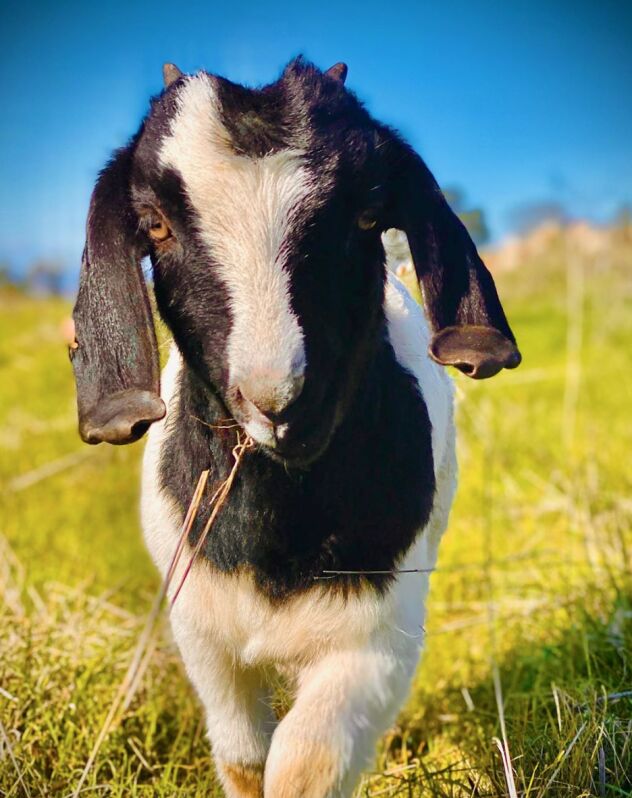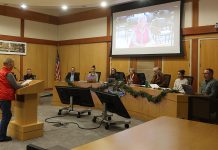
Chasin Goat Grazing, a family-owned business based out of Santa Rosa, has been providing goat grazing services to Sonoma County government agencies, businesses and residents since 2016, and now around 220 of their goats are on Fitch Mountain performing important wildfire fuels management work.
The goats will be in the Fitch Mountain area for about a month, according to Chase Cianfichi, the founder of Chasin Goat Grazing.
“They were there over the weekend working at the Villa Chanticleer property. We just put them across the creek over to that side and there are roughly 220 animals,” Cianfichi said.
The goat grazing project is being funded by a $505,000 California Coastal Conservancy grant for defensible space and fuels management projects, such as goats, on the Fitch Mountain Open Space Preserve.
“A major portion of the grant is going to be for grazing animals,” said Healdsburg Fire Department Division Chief and Fire Marshal Linda Collister.
The herd of goats was delivered to the Villa on July 4. Once they are done in the Fitch Mountain area they will continue their work at the Callihan property, a 147-acre private open space preserve.
“The goats are a tool. They are able to get in where maybe you can’t do a prescribed burn, but we can run the goats in there and reduce the fuel load before a prescribed burn so that it gets the fuel loads down and that’s primarily the goal, to get the fuel loads down,” Cianfichi said. “I wouldn’t say it’s not necessarily where one is better than the other (a prescribed burn). They each have their own applications and different techniques. I know the Healdsburg Fire Department would like to try to do some controlled burns as well later on, so we are just a tool in a tool belt.”
Goats are good at clearing large amounts of brush and can eat almost anything, including poison oak, ivy and blackberry bushes.
“You’re getting rid of a lot of the ladder fuel underneath that stuff and under the trees and that’s where they help out the best,” Cianfichi said.
With reduced ladder fuel, firefighters have an easier time keeping fire on the ground and from going up into the crowns of trees. Once a wildfire reaches the crowns of trees it burns hot and fast and can be extremely difficult to contain as it jumps from tree to tree.
When asked how many goats are typically on a job, Cianfichi said it depends on the size of the grazing site and how quickly the work needs to be done.
While goat grazing is highly effective for fire fuel management, grazing has other benefits such as restoring native plant species, eliminating emissions of traditional land management methods and land fertilization.
“The foot impact of the goats helps aerate the soil and you get that fertilizer. You are taking those plants that are there and re fertilizing it back into the ground so you’re getting a lot of carbon and nutrients into the ground. When it rains it will get all nice and worked in there and hopefully we’ll see new plant growth or you might see some other native plants that are coming back into the area,” Cianfichi said.
Getting to know the folks behind the goats
Cianfichi moved to Petaluma with his family when he was 8 years old. They later moved to Santa Rosa and he went on to attend Santa Rosa High School, where he participated in Future Farmers of America, and then attended Santa Rosa Junior College and Fresno State University.
“I knew I didn’t want a 9-to-5 job and I worked for a couple of ranches and I worked for a custom farming business for a couple summers in high school and I really liked that and then I worked for another dairyman out in Two Rock Valley and I liked it. I’ve always ridden horses and been in that kind of lifestyle,” Cianfichi said.
He said he originally wanted to run cattle, but since that can be a difficult task, he went back to the goats.
“We started in 2016 kind of as a summer project. It was my first year at the junior college and I kind of just took it on. I did a work trade and my friend gave me 10 goats and from there I started doing my grandpa’s buddies’ houses and I thought it was a cool idea and it gave me a little extra money and it just evolved and got bigger and bigger,” Cianfichi said.
He eventually got over a couple hundred animals over the course of 2016, but later had to sell all of his goats so he could finish his degree in animal science production management at Fresno State University.
Toward the end of his last year in school, his cousin said he’d like to get the goat grazing business going again.
“We started doing it and it just took off from there,” Cianfichi said.
Now he has around 2,500 goats as well as sheep. The goats are mostly Spanish crosses and the sheep are primarily Dorper sheep, a South African breed of domestic sheep.
Most of his work is based in Sonoma County, however, he said they’ll also go to Marin County.
When people talk about wildfire preparedness, they often mention goats and the important role that they play in wildfire mitigation and Cianfichi said feels nice knowing that he’s doing something that makes a positive difference.
“It’s definitely nice. There are a lot of people who want to use the goats so it can be overwhelming at times just to try to keep everyone in an orderly waitlist, but at the end of the day, goats work on their own time. When they’re ready to move you have to move them,” he said.
When goats are at a specific site, they are moved and overseen by designated herders.
“They stay on site at night and we have herders that we have through an H-2A Visa program and they help us do everything pertaining to the goats, keeping the fence in front of them, making sure they have food and have water … and if they look sick, letting me know. They are kind of the whole key of the whole grazing aspect,” Cianfichi said.
In terms of adding more goats and sheep to the herd, Cianfichi said they can breed about two lambs and two kids a year.
“Right now is kind of a free for all and some are getting bred. Right now we are looking for a place to purchase to manage it better. We have a plan in place,” Cianfichi said.
He said they are trying to find a ranch near their base in Santa Rosa that could serve as a better place to house and breed the animals.
“We definitely want to stay in Sonoma County and we definitely want to be in this community,” he said.








